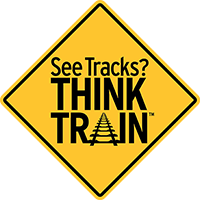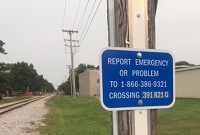Rail safety is essential for everyone - motorists, pedestrians, bicyclists, motorcyclists, bus and truck drivers. There are more than 3,980 railroad public crossings and 3,300 miles of active train tracks in the state of Wisconsin.
In Wisconsin in 2022, four people were killed and 10 people were injured as a result of 41 railroad grade crossing incidents. An additional 4 people died and 7 were injured trespassing on railroad tracks.
Following these few, simple safety tips will help us bring these numbers to zero.
-
Always expect a train at each highway-rail intersection. Freight trains don't travel at fixed times and schedules for passenger trains change.
- Cross train tracks only at designated pedestrian or roadway crossings, and obey all warning signs and signals posted there. If you cross at any other place, you are trespassing and can be ticketed or fined.
- All train tracks are private property.
Never walk on tracks; it is illegal to trespass and highly dangerous. By the time a locomotive engineer sees a trespasser or vehicle on the tracks it's too late. It can take a mile or more to stop a train.
- Trains overhang the tracks by at least three feet in both directions; loose straps hanging from rail cars may extend even further. If you are in the right-of-way next to the tracks, you can be hit by the train.
- Stay alert around railroad tracks. No texting, headphones or other distractions that would prevent you from hearing an approaching train; never mix rails and recreation.
Remember:
- Trains can move in either direction at any time. Sometimes their cars are pushed by locomotives instead of being pulled, which is especially true in commuter and light rail passenger service.
- Today's trains are quieter than ever, producing no telltale "clackety-clack."
Any approaching train is always closer, moving faster, than you think.
- Watch for a second train! When you're at a crossing with more than one track, don't try to cross immediately after the end of the train passes. There may be another train approaching on the other track.
Emergency Notification System (ENS) signs
A blue Emergency Notification System sign is posted at every railroad crossing. If you see a problem at a crossing, call the number listed on the sign as soon as possible and provide the posted crossing number.
Don't get trapped on the tracks
Always make sure before you begin crossing the tracks that there's plenty of room for you to get all the way across before having to stop again. If your vehicle stalls on the tracks, get out immediately and get as far away from it as possible. Then look for the blue ENS sign and call for help.
When approaching a rail crossing, watch for vehicles in front of you, like buses and some trucks, which must stop at the crossing even if there is no train coming. Beware of the optical illusion. It is virtually impossible to accurately judge the distance and speed of an approaching train.
Railroad crossing precautions
Motorcycles/bicycles
- Motorcycles must follow all the safety rules that apply to other motor vehicles.
- In addition, motorcycle and bicycle riders must be alert for the possibility of a rough crossing and skewed crossing.
- Always cross the tracks at as nearly a 90-degree angle as possible.
Stopping requirements
State and federal regulations require motor buses transporting passengers and motor vehicles transporting chlorine, fuel and hazardous materials to stop at all highway-rail grade crossings.
Exempt crossings
Certain crossings are signed as "Exempt" indicating that vehicles usually required to stop at crossings, need not stop at the crossing. This status is granted when it is determined that the exemption will enhance safety and operations. The exemption is typically made for two reasons:
- The risks of a rear-end crash are greater than a train-vehicle crash, such as at crossings with low train volumes and speeds, but high vehicle volumes and speeds.
- Traffic at the crossing is controlled by a traffic signal that is interconnected to the crossing signals and train detection.
Related information